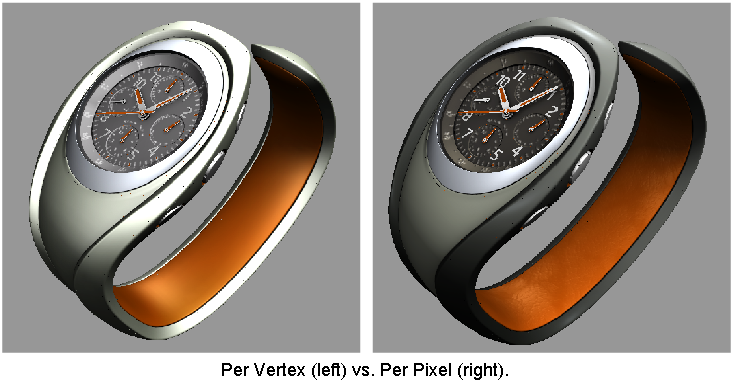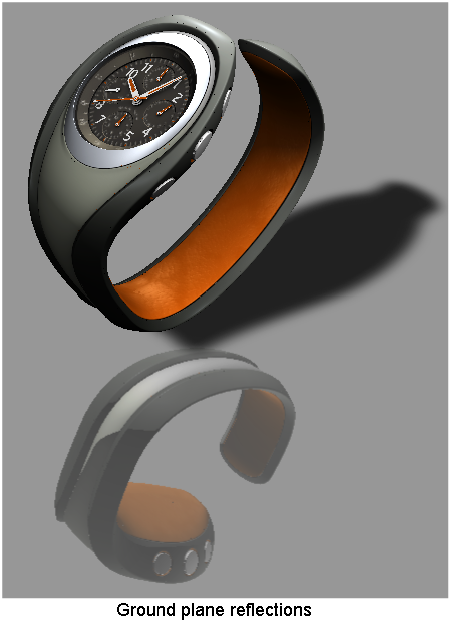Toggles between wireframe and render preview views of the scene.
Hardware shading attempts to show as realistic an image as possible while maintaining interactive speeds. Because of these speed considerations, not all rendering attributes are supported, and the hardware shading accuracy depends on your graphics card’s capabilities. Per-vertex shading does not support as many rendering attributes as per-pixel shading.
The following rendering attributes are shown in the preview:
Before surfaces can be rendered, they must be tessellated, that is, polygonal objects approximating the surfaces have to be
calculated. WindowDisplay > Hardware Shade displays a progress bar during tessellation, indicating the approximate time to completion. It is also possible to escape
tessellation by pressing the
displays a progress bar during tessellation, indicating the approximate time to completion. It is also possible to escape
tessellation by pressing the  key.
key.
Although unlikely, you may experience the following limitations when viewing shaded surfaces:
Re-order surfaces in the SBD window from left to right so that the left-most surface is the surface that is nearest the camera (in the view that you are shading) and the right-most surface is the surface that is farthest from the camera.
To move a surface, select it in the SBD window, hold down the  (Windows) or
(Windows) or  (Mac) key and press the
(Mac) key and press the  key (to move it left) or the
key (to move it left) or the  key (to move it right).
key (to move it right).
 ) and diagnostic shading cause lines to break up.
) and diagnostic shading cause lines to break up.
When diagnostic shading is applied to a selected model, the lines in other models become broken up and difficult to view.
If you dolly (in the perspective view), the models become more difficult to see the further the surfaces are from the camera.
Per vertex provides you with the same quality of shaded mode as was available previously in Alias. Choose Per vertex for a fast approximation of the surface while modeling. Per pixel provides highlights close to the look obtained with the RayCaster, and requires a graphics card that supports this mode. For further information about qualified graphics cards, see http://www.alias.com/qual_charts/.

If you are using textures, you can use approximations to speed the computations in hardware rendering. Texture maps can be rendered at the following square resolutions: 128, 256, 512, 1024, and 2048. You can also turn off texture maps by choosing Off from this pop-up menu. A texture map should not be larger than the size the rendered texture will appear to be. For example, if a label in a finished rendering is to be about 256 x 256 pixels square, it is a waste of computational power to use a texture map and a texture resolution that is greater than that value.
All Lights – Shade surfaces using the lights in the scene, up to a maximum of eight.
Selected Lights – Shade surfaces using any picked lights, up to a maximum of eight.
Warm Cold– Shade surfaces using a preset combination of warm and cool colored lights.
Contrast– Shade surfaces using a preset combination of lights to create a wide range from highlights to shadows.
Default– Shade surfaces using a direction light at the camera and an ambient light. This is the fastest option. This option may be hardware accelerated.
Self-shadows boost the realism of a scene by adding additional information about spatial relationships of objects, and provide information about the shape of an object as it casts shadows on itself.
Self shadows must be turned on in the Hardware shade settings window. This is the master control that determines whether any self-shadows can be cast.
Use self-shadows with either ALL LIGHTS or SELECTED LIGHTS to have control over the shadows based on the lights’ parameters, position, and rotation.
To select which specific lights can cast shadows, use the Light editor’s Cast Shadows button in the Active Effects section. The light editor shadow settings are shared with the software renderer.
The WARM COLD and CONTRAST light settings, while useful for examining a scene, do not create “real” lights, and so, do not provide any controls to change the lights’ position or parameters. With these settings the Self-shadow check box must be toggled ON but shadows do not have to be ON in the light editor.
Shadows cast by the preset lights, WARM COLD and CONTRAST, will only display once the camera has stopped moving. The effect is the same as when “Optimize during tumble” is enabled for user defined lights which correspond to the ALL LIGHTS option in the hardware shade settings.
The DEFAULT light setting does not work with self-shadows.
Clicking Self Shadows in the Optimize during Tumble section may speed up playback.
Self shadows do not work on objects that have any transparency set. They do work on layered shaders that have at least one opaque (not transparent) layer.
Moving lights around in a scene is computationally expensive, and the more lights that are moved, the greater the number of calculations that must be made. Tumbling a scene, where the objects and lights are stationary and the camera moves, is much faster and less expensive computationally.
Enables ground planes, ground plane shadows, and ground plane reflections in hardware shade mode. Options are found in the Ground Plane section of the Environment editor.


Enables shader glow. Most settings are found in the ShaderGlow section of the Environment editor. Be aware that glows require significant calculations that may slow performance. Reflected objects and the ground plane will not show the glow.
If enabled, shows the model as if it were surrounded by long fluorescent light fixtures. The linear reflection tool is only available in hardware shade mode. Settings for this feature are found in Linear Reflection controls in the Environment editor.